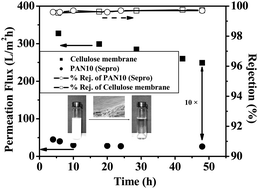A novel class of thin-film nanofibrous composite (TFNC) membrane consisting of a cellulose barrier layer, a nanofibrous mid-layer scaffold, and a melt-blown non-woven substrate was successfully fabricated and tested as an ultrafiltration (UF) filter to separate an emulsified oil and water mixture, a model bilge water for on-board ship bilge water purification. Two ionic liquids: 1-butyl-3-methylimidazolium chloride and 1-ethyl-3-methylimidazolium acetate, were chosen as the solvent to dissolve cellulose under mild conditions. The regenerated cellulose barrier layer exhibited less crystallinity (determined by wide-angle X-ray diffraction, WAXD) than the original cotton linter pulps, but good thermal stability (determined by thermal gravimetric analysis, TGA). The morphology, water permeation, and mechanical stability of the chosen TFNC membranes were thoroughly investigated. The results indicated that the polyacrylonitrile (PAN) nanofibrous scaffold was partially imbedded in the cellulose barrier layer, which enhanced the mechanical strength of the top barrier layer. The permeation flux of the cellulose-based TFNC membrane was significantly higher (e.g. 10×) than comparable commercial UF membranes (PAN10 and PAN400, Sepro) with similar rejection ratios for separation of oil/water emulsions. The molecular weight cut-off (MWCO) of TFNC membranes with cellulose barrier layer was evaluated using dextran feed solutions. The rejection was found to be higher than 90% with a dextran molecular weight of 2 000 KDa, implying that the nominal pore size of the membrane was less than ∼50 nm. High permeation flux was also observed in the filtration of an emulsified oil/water mixture as well as of a sodium alginate aqueous solution, while high rejection ratio (above 99.5%) was maintained after prolonged operation. A variation of the barrier layer thickness could dramatically affect the permeation flux and the rejection ratio of the TFNC membranes, while different sources of cellulose, ionic liquids, and non-woven supports did not. As ionic liquids can be recycled and reused without obvious decomposition, the chosen method also demonstrates a benign pathway to fabricate the cellulose barrier layer for other types of membranes.


 Please wait while we load your content...
Please wait while we load your content...